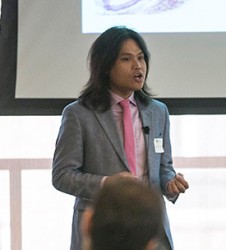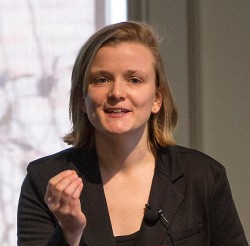
Topics ranged from giving nanoparticles the aquatic skills of an Olympic swimmer so they can deliver anti-cancer drugs more effectively…to developing an ultrasonic Trojan horse to destroy tumors…to using blue light as an alternative to antibiotics in controlling bacterial infections.
But in the end, it was Vanderbilt University School of Engineering’s Thushara Gunda who took first place — dazzling expert judges with her work helping Sri Lankan farmers mitigate drought and other conditions they face.
The event was the finals of the fourth annual Three Minute Thesis (3MT) Competition held Friday at the Student Life Center. It pitted Vanderbilt graduate students against one another in an unusual test of communications skills: summarizing their 80,000-word doctoral theses in terms that members of the public can understand — plus delivering it in less than three minutes with a single PowerPoint slide.
This year, 42 students conducting research in fields ranging from microbiology, materials science and biomedical engineering to English, anthropology and religion participated in the competition put on by the Graduate Student Council (GSC). Four preliminary panels were held in the morning. Out of these performances, 10 contestants were selected to compete in the finals for three cash awards: $1,500 for first place, $750 for second place and $350 for people’s choice.
3MT was invented at the University of Queensland in Australia in 2008 and has proven so popular that it has now spread to more than 200 universities in 19 countries. Vanderbilt was one of the first universities in the U.S. to pick it up.
Similes and metaphors abounded. One student likened the dopamine transporter system that he is studying to the “brain’s own vacuum cleaner” and explained that defects in this system may be linked to a number of different forms of mental illness. A student who is working on extending the time that a nanoparticle drug delivery system can survive in the body described this as analogous to giving the particles swimming skills equivalent to those of Michael Phelps. Another student drew from Greek mythology to compare the cancer immunotherapy method that she is studying to the Trojan Horse: the method uses focused ultrasound to trick cancer cells into dropping their defenses against the body’s immune cells.
At the end of the day, the winners were:
First Place: Gunda, who is in the Department of Civil and Environmental Engineering, whose presentation, “Risky Business: using games to understand farmer decisions in Sri Lanka,” described how she assembled an interdisciplinary team of researchers who used game theory to develop a board game that captures the important factors that Sri Lankan farmers must consider when deciding to plant rice or other crops each season. By observing farmers playing this game, Gunda and her colleagues have gathered enough information to develop a computer model that they hope will allow them to come up with better crop selection strategies.
Second Place: Kim Montaniel in molecular physiology and biophysics, whose presentation, “Anti-miR-762 therapy prevents and reverses aortic fibrosis and associated organ damage,” summarized discovery of a treatment that can stop and even reverse the tissue damage to the aorta and associated organs caused by high blood pressure. There is currently no effective treatment for aortic stiffening due to hypertension.
People’s Choice: Alice Leach in the interdisciplinary program in materials science used the Road Runner cartoon characters in her presentation, “A Little Goes a Long Way: Nanoparticles for Solar Energy Capture,” to explain why solar energy’s diffuse and intermittent nature make it difficult to harness despite its tremendous abundance – it is similar to the problem Wile E. Coyote has in trying to capture the Road Runner – and how nanotechnology (not made by the Acme Company, I trust) can substantially improve solar cell efficiency.
Alice Leach giving her People’s Choice award-wining presentation (Daniel Dubois / Vanderbilt University)
Finalist judges were Lauren Benton, dean of the College of Arts and Science; Timothy Henderson, executive director of Humanities Tennessee; Hedy Weinberg, executive director of ACLU of Tennessee; Ralph Schulz, president of Nashville Chamber of Commerce; Lawrence Marnett, associate vice chancellor for research and senior associate dean for biomedical sciences; Cynthia Cyrus, vice provost for learning and residential affairs; Susan Edwards, director of the Frist Art Center; Bonnie Miller, associate vice chancellor for health affairs, senior associate dean for health science education; and Alan Kantrow, chief learning and communications office of the Governance Lab at New York University.
Media Inquiries:
David Salisbury, (615) 322-NEWS

